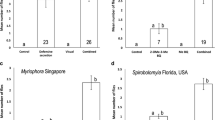Abstract
Members of a wild group of wedge-capped capuchin monkeys (Cebus olivaceus) intentionally anoint themselves with millipedes (Orthoporus dorsovittatus). Chemical analysis revealed these millipedes secrete two benzoquinones, compounds known to be potently repellent to insects. We argue that the secretion that rubs off on the monkeys in the course of anointment provides protection against insects, particularly mosquitoes (and the bot flies they transmit) during the rainy season. Millipede secretion is so avidly sought by the monkeys that up to four of them will share a single millipede. The anointment must also entail risks, since benzoquinones are toxic and carcinogenic. We suggest that for capuchins the immediate benefits of anointment outweigh the long-range costs.
Similar content being viewed by others
REFERENCES
Altmann, J. 1974. Observational study of behavior: Sampling methods. Behaviour 49:227–265.
Attygalle, A. B., Xu, S.-C., Meinwald, J., and Eisner, T. 1993. Defensive secretion of the millipede Floridobolus penneri. J. Nat. Prod. 56:1700–1706.
Blum, M. S. 1981. Chemical Defenses of Arthropods. Academic Press, New York.
Catts, E. P. 1982. Biology of New World bot flies: Cuterebridae. Annu. Rev. Entomol. 27:313–338.
Eisner, T., Alsop, D., Hicks, K., and Meinwald, J. 1978. Defensive secretions of millipeds, pp. 41–72, in S. Bettini (ed.). Handbook of Experimental Pharmacology. Springer-Verlag, New York.
El-Mofty, M. M., Khudoley, V. V., Sakr, S. A., and Fathals, N. G. 1992. Flour infested with Tribolium castaneum, biscuits made of this flour, and 1,4-benzoquinone induce neoplastic lesions in Swiss albino mice. Nutr. Cancer 17:97–104.
Fairhurst, C. P. 1993. Poisonous exudates of millipedes. Anal. Proc. 30:429–430.
Huffman, M. A., Gotoh, S., Turner, L. A., Hamai, M., and Yoshida, K. 1997. Seasonal trends in intestinal nematode infection and medicinal plant use among chimpanzees in the Mahale Mountains, Tanzania. Primates 38:111–125.
Lauer, U., Anke, T., and Hansske, F. 1991. Antibiotics from basidiomycetes. XXXVIII. 2-methoxy-5-methyl-1,4-benzoquinone, a thromboxane A2 receptor antagonist from Lentinus adhaerens. J. Antibiot. 44:59–65.
Milton, K. 1996. Effects of bot fly (Alouattamyia baeri) parasitism on a free-ranging howler monkey (Alouatta palliata) population in Panama. J. Zool. London 239:39–63.
Newton, P. 1991. The use of medicinal plants by primates: A missing link? Trends Ecol. Evol. 6:297–299.
O'brien, T. G. 1990. Determinants and consequences of social structure in a Neotropical primate, Cebus olivaceus. PhD dissertation. University of Florida, Gainesville.
O'brien, T. G. 1991. Female-male social interactions in wedge-capped capuchin monkeys: Benefits and costs of group living. Anim. Behav. 41:555–567.
Page, J. E., Huffman, M. A., Smith, V., and Towers, G. H. N. 1997. Chemical basis for Aspilia leaf-swallowing by chimpanzees: A reanalysis. J. Chem. Ecol. 23:2211–2226.
Peschke, K., and Eisner, T. 1987. Defensive secretion of the tenebrionid beetle, Blaps mucronata: Physical and chemical determinants of effectiveness. J. Comp. Physiol. 161:377–388.
Robinson, J. G. 1986. Seasonal variation in use of time and space by the wedge-capped capuchin monkey, Cebus olivaceus: Implications for foraging theory. Smithson. Contrib. Zool. 431:1–60.
Rodriguez, E., Aregullin, M., Nishida, T., Uehara, S., Wrangham, R., Abramowski, Z., Finlayson, A., and Towers, G. H. N. 1985. Thiarubrine A, a bioactive constituent of Aspilia (Asteraceae) consumed by wild chimpanzees. Experientia 41:419–420.
Srikosamatara, S. 1987. Group size in the wedge-capped capuchin monkey (Cebus olivaceus): Vulnerability to predators, intragroup and intergroup feeding competition. PhD dissertation. University of Florida, Gainesville.
StÄrk, A., Anke, T., Mocek, U., and Steglich, W. 1991. Omphalone, an antibiotically active benzoquinone derivative from fermentations of Lentinellus omphalodes [1]. Z. Naturforsch. 46c:989–992.
Troth, R. G. 1979. Vegetational types on a ranch in the central llanos of Venezuela, pp. 17–30, in J. F. Eisenberg (ed.). Vertebrate Ecology in the Northern Neotropics. Smithsonian Institution Press, Washington, D.C.
Wrangham, R. W. 1995. Relationship of chimpanzee leaf-swallowing to a tapeworm infection. Am. J. Primatol. 37:297–303.
Author information
Authors and Affiliations
Rights and permissions
About this article
Cite this article
Valderrama, X., Robinson, J.G., Attygalle, A.B. et al. Seasonal Anointment with Millipedes in a Wild Primate: A Chemical Defense Against Insects?. J Chem Ecol 26, 2781–2790 (2000). https://doi.org/10.1023/A:1026489826714
Issue Date:
DOI: https://doi.org/10.1023/A:1026489826714




